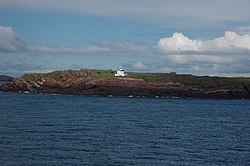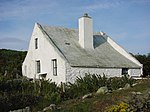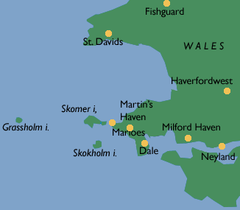Skokholm
| Skokholm Welsh: Ynys Sgogwm | |
 Skokholm and its lighthouse | |
|---|---|
| Location | |
| Location: | 51°41’52"N, 5°16’50"W |
| Grid reference: | SM734050 |
| Area: | 247.1 acres |
| Data | |
Skokholm is an uninhabited island 2½ miles off the coast of south-western Pembrokeshire, lying south of the neighbouring island of Skomer. The whole island is a Site of Special Scientific Interest as is Skomer. The surrounding waters are a marine reserve, all part of the Pembrokeshire Coast National Park. It is the fourth largest of Wales' offshore islands.
Geography
At its greatest, Skokholm is a mile long and half a mile wide, covering 247.1 acres. Made up of Old Red Sandstone, its cliffs stand between 70 feet in the northeast, to 160 feet in the southwest. Battered by storms, the high cliffs and isolated nature of the island makes it a haven for seabirds.[1] There is a rock outcrop close to the centre of the island, which provides shelter to the island's only structures.
Name and ownership
The name of Skokholm is Old Norse for "Wooded Island" very similar to the name of the Swedish capital, Stockholm. The island was named by Norsemen or Danes who visited the Bristol Channel.
An undated charter is to be found in the British Museum by which William Marshal the Younger, Earl of Pembroke 1219-31, grants to a certain Gilbert de Vale land in Ireland in exchange for lands in Pembrokeshire, including the island of 'Scoghholm'.[2] The revenue from the island from 1324 to 1472 was recorded in Ministerial Accounts. Some years later, the islands were in the hands of Sir John Perrott, natural son of Henry VIII. The island was bought for £300 in 1646 by William Philipps, a barrister, and it was kept in the family for the next 360 years. In 2005 his descendant Mrs. Osra Lloyd-Philipps (1920 - 24 March 2005) of Dale Castle died. The trustees of the estate decided to offer the island for sale, with first refusal going to the Wildlife Trust of South and West Wales, who had managed the island for the last 50 years on their behalf. After a large fundraising effort, the island was successfully purchased in April 2006 for £650,000,[3] and designated a national nature reserve in December 2008.[4]
Bird observatory
In 1933[5] Skokholm was functioning as a bird observatory, the first in Britain, founded by Ronald Lockley; its prime function was the ringing of wild birds of resident, visiting or migrating species and research.[6][7] Lockley started the Pembrokeshire Bird Protection Society in 1938,[8] now incorporated in the Wildlife Trust of South and West Wales.[9] In 1948 the West Wales Field Society (WWFC), also now Wildlife Trust of South and West Wales, first took the Lease of Skokholm from the owners of the Dale Castle Estate. The WWFC followed on the Lease by Ronald Lockley which had run from 1927 but direct involvement commenced two years earlier when in 1946 the Bird Observatory was re-opened after the war. Ringing on Skokholm ceased from 1976.[10] During the period of radar studies of migration around 1960 it became clear that bird movements as observed at the Observatories were by no means representative of the whole and, inevitably, the significance of the Observatories in the study of migration waned. Skokholm had been the site of the most thorough British studies of the Storm Petrel and Razorbill amongst the seabirds and the Oystercatcher and the Wheatear amongst the landbirds. 'There can be few other islands anywhere in the world that can boast the continuity of biological recordings, save for wartime years, that has taken place on Skokholm.' John Fursdon, Warden 1946.
Natural history
Plants
Most of Skokholm is simple sub-maritime grassland, with the wetter areas graded as heath and some salt marsh. All of these areas house common natural species including Three-lobed Water Crowfoot, Tree Mallow, Marsh St. John’s Wort, Small Nettle, and Sea Campion.
Fungi
Larger fungi were extensively studied in the 1940s and 1950s by Frederick Parker-Rhodes who published a series of papers based on his research on the island.[11] Skokholm is the type locality for the corticioid species Trechispora clanculare (Park.-Rhodes) K.H. Larss., described as new to science from the island where it was first found in a puffin burrow.[12] Due to its isolated nature, Skokholm houses British nationally scarce lichens including Golden Hair lichen (Teloschistes flavicans).[1]
Bird life and larger fauna
Ronald Lockley, a pioneering ornithologist, especially famous for his work on puffins and shearwaters, wrote many books featuring Skokholm, where he lived and researched for many years.
Today Skokholm is the site of the third largest Manx shearwater colony (15% of world population),[1] and 20% of Europe's population of storm-petrels, as well as 4,500 puffins and 2000 guillemots and razorbills.[13] There are also large colonies of Lesser Black-backed Gulls, Herring Gulls and Great Black-backed Gulls. The island is a breeding site for Oystercatchers, Chough, Skylark and Wheatear.[1]
In addition to the impressive numbers of breeding seabirds, it is a good site for passage migrants, including Chiffchaff, Willow Warblers, Whitethroat, Redstart, and Spotted and Pied Flycatchers.[1]
After the Norman invasion of north Pembrokeshire led by Robert fitz Martin, the Normans built a rabbit farm on the island, later revived during the Victorian era.[1] As a result, the island houses an example of long-term rabbit-maintained grass. House mice were accidentally introduced in the late 19th century.[1]
Buildings

The first Skokholm Lighthouse was built in 1776, and then rebuilt at its present site in 1861. The lighthouse forms a triangle of protection into Milford Haven along with the lighthouses at South Bishop and the Smalls. Automated in 1983, it is now monitored and controlled from the Trinity House Operations Control Centre at Harwich in Essex.[14]
The original farm cottage restored by Lockley is now a Grade II listed building, while the surrounding farm buildings are being converted to accommodation units.[1]
Transport
After their purchase of the island, and taking into account the poor and dilapidated nature of the island's infrastructure, presently Skokholm may only be visited by prior arrangement with the Wildlife Trust of South and West Wales.
Connecting boats leave from Martin's Haven, with booked visitors able to stay on this island in basic accommodation. In 2010, the trust announced improvements to the island's landing jetty to allow easier access, with a £38,250 development project funded by Crown Estates and RWE Npower.[15]
Outside links
| ("Wikimedia Commons" has material about Skokholm) |
- Skokholm page on the Wildlife Trust of South and West Wales Website
- Press release on the purchase of Skokholm Island
- www.geograph.co.uk : photos of Skokholm
- Photos of Skokholm and some of its inhabitants
References
- ↑ 1.0 1.1 1.2 1.3 1.4 1.5 1.6 1.7 "Skokholm Island". ccw.gov.uk. http://www.ccw.gov.uk/landscape--wildlife/protecting-our-landscape/special-landscapes--sites/protected-landscapes/national-nature-reserves/skokholm-island.aspx. Retrieved September 2, 2010.
- ↑ I know an Island. Lockley, R. M. 1938, p32 (Island History)
- ↑ "Skokholm sold after trust appeal". BBC Wales. April 10, 2006. http://news.bbc.co.uk/1/hi/wales/south_west/4894852.stm. Retrieved September 2, 2010.
- ↑ BBC News article on Skokholm Island gaining nature reserve status
- ↑ Natural History of Wales, Condry, W M
- ↑ Shearwaters, Lockley, R M
- ↑ Dream Island, Lockley, RM (1930)and Island Days (1943)
- ↑ Wind, Waves, Wildlife, Skokholm Island by John Fursdon, Friends of Skokholm and Skomer(2006)
- ↑ The Island Naturalist, Wildlife Trust West Wales, Autumn 1998, no 36, ISSN 1367-6466, p4-11
- ↑ Skokholm and Skomer Nature Reserves Report for 1976. WWNT
- ↑ Parker-Rhodes, F. (1954). "The Basidiomycetes of Skokholm Island. I. Annotated species list". Transactions of the British Mycological Society 37 (4): 324–342.
- ↑ Parker-Rhodes, F. (1955). "The Basidiomycetes of Skokholm Island". XIII. Echinotrema clanculare gen. et sp. nov." Transactions of the British Mycological Society 38 (4): 366–368.
- ↑ (BBC Nature News), "Nature reserve 'boost' for island", 6 December 2008..
- ↑ "Skokholm Lighthoure". Trinity House. http://www.trinityhouse.co.uk/interactive/gallery/skokholm.html. Retrieved September 2, 2010.
- ↑ "Skokholm landing quay is improved". BBC Wales. March 24, 2010. http://news.bbc.co.uk/local/southwestwales/hi/people_and_places/newsid_8583000/8583549.stm. Retrieved September 2, 2010.

